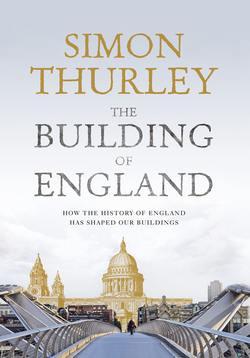Читать книгу The Building of England: How the History of England Has Shaped Our Buildings - Simon Thurley - Страница 42
Оглавление
The years between 1350 and 1530 produced a distinctive architectural language of considerable beauty and sophistication in England that was quite different from its continental counterparts. This individuality was to remain a hallmark of English building during the following century.
Introduction
Between the Black Death and the Reformation building in England entered a long period of architectural consensus. For nearly 200 years designers worked with an architectural language that, with relatively minor modulation and a greater or lesser degree of elaboration, retained its essential stylistic components. Through this long period new building types developed, new materials became fashionable and the way people lived, thought and worshipped changed. Yet, while the differences in buildings built between 1200 and 1300 are readily discernible, the same cannot be said of buildings built between 1400 and 1500. Precisely dating 15th-century buildings on stylistic grounds alone is a hazardous business, but the skills to do the same for 13th-century buildings can be readily developed.
Generations of scholars have made many attempts to explain this, each discrediting the views of the previous generation but each adding to the subtlety and complexity of our understanding.1 Yet there are some important points that help. Gothic was an international architectural language, but after 1300 it acquired, if you like, many national dialects. Whilst Henry III’s Westminster Abbey (p. 127) and St Stephen’s Chapel, Westminster (p. 144), were consciously influenced by French models, this cannot be said of buildings after 1350. Architects looked to domestic models rather than to France, and so England, Spain, France, Flanders and elsewhere developed their own indigenous varieties of building. These varieties or dialects sometimes fed from one another; others acquired a particularly distinct tone. In England the dialect was very individualistic – and quite unlike those that developed elsewhere – and formed a national school of design that was strengthened by a close-knit network of masons and architects operating in a geographically defined nation state.2
This turning inwards of architectural design took place against a tumultuous background of international warfare, civil war, political instability, and economic and social disaster. It is this mix of apparent instability on the one hand with architectural consensus on the other that this chapter explores.
A Century of Crisis 1300–1408
Although 13th-century England was rich and populous, by 1300 both wealth and population growth had reached a temporary peak, with the century that followed bringing financial setbacks and a decline in population. Underlying many of the problems was a very modern concern – climate change. Between 1290 and 1375 the British climate became unstable and unpredictable; a series of wet summers prevented crops from ripening, rotted seed in the ground, and nurtured pests and disease, while coastal flooding inundated thousands of acres and torrential rain made thousands more unusable. Between 1315 and 1322 there was crop failure and widespread famine, killing perhaps half a million people. Starting in the 1330s the countryside began to contract, villages were abandoned, clay and sandy soils were left for more fertile areas.3 During the 13th-century expansion in Dartmoor hamlets and farmsteads had been built on agriculturally marginal land. In 1300 in the southern hamlet at Hound Tor there were four longhouses and seven ancillary buildings. As the climate deteriorated the farmers who occupied these built stone walls to keep the moorland from eating up their fields. Initially they must have had success, but in the 1330s they built corn driers to combat the effect of wet summers. This cannot have been enough, for the whole settlement was abandoned less than twenty years later.4
A better-developed agricultural economy might have resisted the effects of climate change but climatic factors brought an immature system to its knees, particularly at the margins. A second global factor undermined 13th-century stability – a failure in the money supply. This was partly caused by a genuine shortage of silver; the mines simply couldn’t produce enough to supply the mints as well as the luxury-goods market. But in part it was a result of taxation demands made by the Crown to pay for war, meaning that in the 1330s and 40s there was often no money available to buy goods.
